 |
                        
|
WilliamsF1 BMWFW26
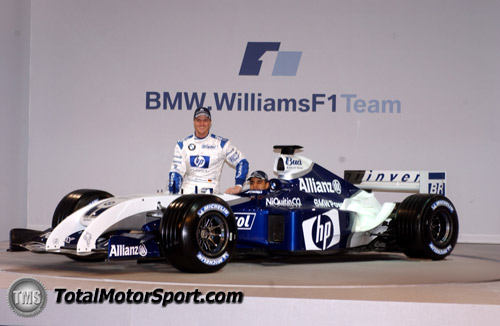
2003 was, by any metric, the most competitive season of the WilliamsF1/BMW partnership since the formation of the alliance in 2000. The team won four races, completed more racing laps than any other competitor, and finished a close second to Ferrari in the FIA Formula One Constructors' Championship.
A wide variety of elements underpinned this success, not least the sage stewardship of team bosses Frank Williams, Patrick Head and Mario Theissen, and the race winning performances of Juan Pablo Montoya and Ralf Schumacher.
But at the very heart of the team's 2003 success that pushed the previously dominant Scuderia Ferrari to the wire was the WilliamsF1 BMW FW25. The car, simply put, was the fundamental building block of this performance.
While the FW25 was stock piling silverware on the racetrack (albeit not quite enough to elevate the BMW WilliamsF1 Team to the status of champions), its architects were busying themselves with its replacement, the FW26. "The FW26 is not an iteration of its predecessor, which might surprise some people given the former car's relative success", says Chief Designer, Gavin Fisher.
But explaining the design approach to the new car, Fisher continues, "You cannot stand still or relax your development pace for a single minute in Formula One. The sport's history is populated with teams who thought they had made it to the top, only to find the game had moved on around them", he explains.
When pressed to define the FW26, Fisher confesses a dislike for the use of the term 'radical', "It is devalued because it is over-used", he reflects, "And to a large extent the possibility is excluded by the restrictive technical regulations that govern Formula One. That said, it will be immediately evident to onlookers
that a high degree of innovative design has gone into the FW26". Not so much an iteration, but a step change, and as such, the second carried out by the WilliamsF1 design team in as many seasons.
When pushed on the principle of this approach, Fisher admits that it is not a strategy without risk. "For sure the FW26 could have been a straightforward evolution of the FW25, and it would undoubtedly have been a quick car. But a car that would be quick enough to win the title? That would have been too dependent on the relative performance of other teams. We wanted to ensure that we had pushed our development as far as it could go." He continues, "Such a progressive approach has produced a stimulating atmosphere in which everyone involved in the project is challenged and invigorated, and simply put, it's an environment where people perform better".
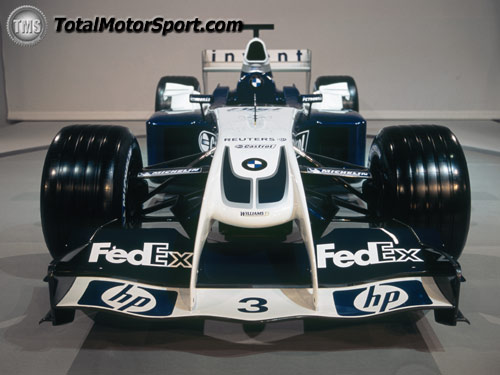
In the hothouse design environment, the demands on individuals have been high, caused not only by the magnitude of the changes relative to FW25, but also from the intended earlier launch date. "We were conscious that the inability to extract the full potential of the FW25 until well into the season was a significant contribution to our failure to win either Championship. The earlier launch date for FW26 is a clear statement of our intent to be in a position to win from the first race onwards. This has obviously put us under considerable pressure during the design phases, but we are confident that the efforts made, combined with an intensive pre-season development programme, will see us realise our goals."
The challenges of a fundamentally ground-up design process are multiplex. Routine design improvement processes involve isolating sub-optimal performing elements of a race car, and iterating or improving the design from the original position. But the 26 borrows little from its predecessor, and as a consequence, every element, no matter how ancillary, must be designed from scratch.
Each individual element demands its own design time. Thereafter, original designs must be validated, in terms of their fabrication or manufacturing specification, their regulation compliance, their operational performance, and finally, in terms of packaging or integration into the wider assemblies that make up the car.
The final part of the FW26 jigsaw is its absorption of the revised 2004 technical regulations. "Every year there is some form of rule revision, but in truth next year represents a fair degree of stability. The chassis rule changes primarily relate to the geometries of the engine cover, rear wing elements and end plates, which have been driven by commercial factors. Whether or not these have contributed favourably to the aesthetics of the cars is down for the individual to judge", says Fisher.
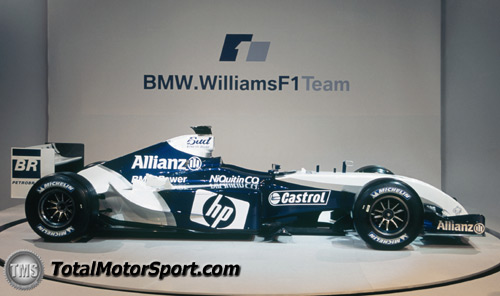
In many ways, the FW26 is not dissimilar to a tube of toothpaste squeezed at both ends. A wholesale change in the design basis for the car has created much more work for the design team, but in turn the changes require more validation, and hence the car has been scheduled to appear on the test track earlier in the cycle.
The WilliamsF1 BMW FW26 amounts to a bold initiative by the team. And in the same way that the FW25 underpinned the most successful season the Anglo-German partnership has enjoyed, so to the FW26 will prove to be the foundation of the team's fortunes in 2004. Gavin Fisher, its principle architect confirms the team's philosophy, "There is a great deal of anticipation on our part about this new car. It is has challenged us throughout its development, and there is certainly a sense that the day that it runs for the first time will be more significant than launch days in previous years. All of the team members will be proud that they have made enormous efforts to push the performance of this car as far forward as possible, and that in doing so will have written the opening chapter in what will become a successful season".
Technical specification FW26
Transmission: WilliamsF1 semi-automatic
Clutch: AP
Chassis: Carbon Aramid epoxy composite, manufactured by WilliamsF1
Suspension: WilliamsF1
Steering: WilliamsF1
Cooling System: Water and oil radiators
Brakes: Carbon Industrie carbon discs and pads operated by AP calipers
Lubricants: Castrol
Fuel: Petrobras
Wheels: O.Z: 13 x 12 front, 13 x 13.7 rear
Tyres: Michelin
Cockpit Instrumentation: WilliamsF1 digital data display
Steering Wheel: WilliamsF1
Driver's Seat: Anatomically formed in carbon/epoxy composite material with Alcantara covering
Extinguisher Systems: WilliamsF1/Safety Devices
Front Track: Maximum allowance
Rear track: Maximum allowance
Weight: 605 kg including driver and camera
BMW P84 - Power And Endurance
Times are changing. While the "short burner" delivers extra power and used to provide a sensation for a single qualifying lap in Formula One, there is now a need for long-life power units. The Formula One Sporting Code introduced by the FIA for the coming 2004 season stipulates the use of a single engine for each vehicle over the entire Grand Prix weekend. This increases the required duration of an engine to 800km. It doubles the distance covered by engines competing in the 2003 season, where the same engine was already being used for qualifying and racing. This represents a considerable challenge for BMW engineers.
Mario Theissen encapsulates the new requirement in a simple equation:
"If an engine has to have a longer service life, every component must in principle be designed to be tougher. This means that the engine will get bigger and heavier, and that is at the expense of revolutions and hence power. Minimising these losses while guaranteeing endurance are the goals we have to work towards."
The BMW P84 was developed by the team of engineers led by Heinz Paschen, Head of BMW F1 Development, in close co-operation with the specialists from the BMW Research and Innovation Centre (FIZ). It has been tailor made for the regulation requirements of the 2004 season.
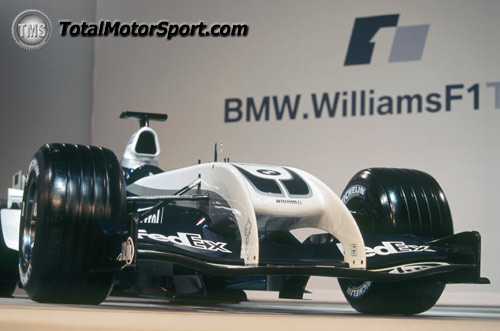
Work on the new BMW engine began in Munich even earlier than in previous years. The team of engineers already started working on a specification for the engine powering the 2004 season in November of 2002. In May 2003, the first version of the P84 was up and running on the test rig in Munich. Over the coming weeks, a number of other versions of the BMW P84 came on stream. Paschen says, "The key factor here was to prove 'fit' for the increased running distance". The version of the engine finally intended for the FW26 was put on the test rig for the first time in July 2003 before being tested in an interim car at Monza on 4 September. From October, work focused on final link-up with the chassis, and circuit testing continued in November.
Specification And Priorities For 2004
The design of the BMW P84 engine is based on its predecessor, but every single component was affected by the new specifications. The engine's design priorities for the 2004 season are: the same dependability must be guaranteed for significantly longer running times while sacrificing as little performance as possible. Material specialists at the BMW Research and Innovation Centre also helped to ensure that the effect on dimensions and weight was kept to a minimum, by developing the new heat-treatment procedures that enhanced endurance properties.
Paschen adds that "We were already so geared up in quality control with the processes that had been running in 2003 that the non-conformance quota in testing and racing was reduced drastically." The final endurance tests on the dynamic test rig is once again carried out using the Monza circuit profile because at 73%, this track has the highest full-throttle section. However, qualification for use was increased over 800 kilometres.
Revolutions Yesterday And Tomorrow
The BMW P82 was the engine used by the BMW WilliamsF1 Team in the 2002 season. The last version of this engine achieved revs of 19,050 per minute. For the following season, new regulations were introduced for 2003 including no engine changes permitted between qualifying and racing.
The duration requirement of an engine, including the race distance, was increased therefore to around 400 kilometres by the flying lap on Saturday. "On paper, that's not too big an increase", explains Theissen, "But it involves a more complex load profile for the engines. It's rather like sending a marathon runner in to run a sprint just before the race starts." Despite these new endurance specifications, BMW succeeded in achieving further increases in engine speed and performance. During the final race of the season in Japan, the BMW P83 clocked up an impressive 19,200 rpm and delivered well above 900 bhp. And it was also a model of reliability.
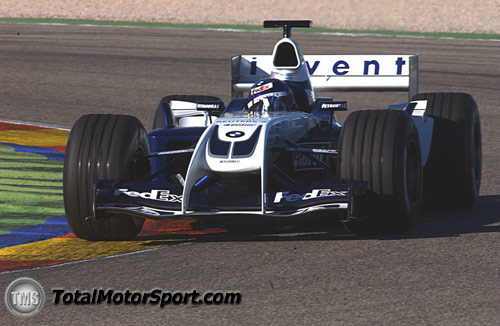
The only engine damage during the 2003 season was sustained in the Austrian Grand Prix. This was due to a water leak in the cooling circuit. Theissen recalls that, "Without cooling water, even the best engine in the world isn't going to get very far".
Theissen is expecting an overall reduction in engine speed and says, "At the start of 2003, I would have guessed at a reduction of 10 percent for 2004. We're now reckoning on less".
From 2004, BMW engineering is no longer restricted to the engine. The expanded co-operation between BMW and WilliamsF1 will see the experts in Munich extending their support for their partners in Grove in some areas of gearbox, electrical and electronic systems, and aerodynamics. This will take the mutual spin-offs derived from Formula One and volume production in the BMW Research and Innovation Centre beyond the engine. The gearbox casing and other components will be manufactured at BMW. The BMW Research and Innovation Centre will be working on aerodynamic development in the area of simulation and calculation.
Synergies Between F1 And Volume-production Development
"The Formula One project is a massive technology laboratory for BMW", comments Theissen. "The main reason for our company re-entering Formula One was to benefit from synergy effects that arise between development for Formula One and volume production", he confirms.
One thing was clear right from the start. The BMW engines for the world's most advanced racing were going to be developed and manufactured in Munich in the cradle of the parent company. The BMW Technology and Innovation Center would play a key role in this process. The Formula One manufacturing facility was set up less than one kilometre away from this think-tank, and the two are fully integrated. "The BMW Research and Innovation Centre represents the future of BMW", explains Theissen. "That's where the most highly skilled engineers are working in high-tech research and development facilities. The BMW Research and Innovation Centre has massive resources and we benefit from these resources directly. Correspondingly, the extreme technical requirements of Formula One involvement and the fast development speed constitute a unique test bed for our engineers."
BMW has turned the vision of a seamless process chain into reality at a dedicated facility from conception, through design, casting, manufacture of components, setup and test phase through to dedicated electronic engine management. This system eliminates transport paths, and all the know-how developed can flow into volume production.
Casting Technology And Manufacture
The casting quality of the engine block, cylinder head and gearbox largely determines the performance and endurance of the power unit. Leading-edge casting technologies with maximally precise process management yield lightweight components with very high stiffness. In order to safeguard these qualities, BMW has a foundry in Landshut to cast components for vehicles manufactured in volume production. A dedicated Formula One casting facility was added in 2001. Theissen adds that, "The two departments work under joint management. This guarantees ongoing exchange of information".
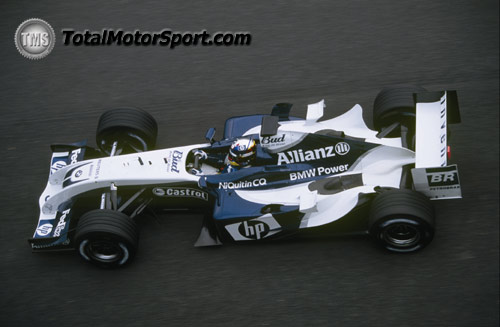
Oil sumps for the M3, M5 and Z8 models and the intake manifold for the eight-cylinder diesel engine are using the same sand casting procedure used for the Formula One V10.
A Formula One parts manufacturing facility was set up alongside the facility for volume components almost at the same time as the Formula One foundry. The Formula One team manufactures camshafts and crankshafts for the BMW P84 in the same location.
WilliamsF1 is meanwhile also benefiting from the work of the two departments. The aluminium gearbox casing for the FW26 is being manufactured in a sand casting process in Landshut and other gearbox components come from BMW Formula One production. Gearwheels are produced in Dingolfing in parallel with volume production.
Electronics In Grand Prix Racing And On The Road
Engine management is subject to immense demands by an engine which races at 19,000 rpm while still having to be driveable at low revs. Ignition timing and fuel supply must be perfectly tuned to the order of milliseconds in order to achieve optimum efficiency - maximum power for minimum fuel consumption. Low consumption means improved lap times and more flexibility for racing strategy. Aside from engine management, onboard electronics are also responsible for monitoring all functions.
The expertise of the electronics specialists at the BMW Research and Innovation Center gave BMW the confidence to develop its own Formula One engine management systems instead of having to resort to racing specialists. Engineers who normally design the onboard electronic systems for the BMW M3 and M5 models have also developed the engine management system for Formula One engines. The expertise they gain in this field flows back into volume production. Top BMW models like the 7 Series and the M Series cars already have two microprocessors that BMW first deployed and tested in Formula One. Memory technology previously used successfully in Formula One has also been deployed for Internet access and the navigation system in the BMW 7 Series. Theissen adds that, "When it comes to monitoring functions, we are also gaining knowledge that can be used for road vehicles. Timely warnings and automated electronic intervention are also relevant to safety there, and they protect vehicles against damage".
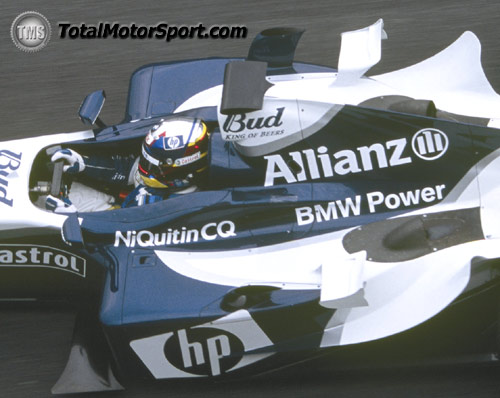
Other automated technology originated in Formula One is also being used in the BMW M3. The "Sequential M Gearbox - SMG with DRIVELOGIC" and the "acceleration assistant" owes its origins to Formula One. The SMG drive concept offers F1 gearbox technology for everyday operation. Drivers can change gear electronically using a paddle behind the steering wheel. Just like in Formula One, an electrical hydraulic system replaces the mechanical clutch and gearshift procedure, and the drivers operating the SMG system can also change gear while their foot remains on the accelerator. The "acceleration assistant" is an automatic system which allows drivers to move off from rest with programmed, regulated slip. This is comparable with the launch control familiar from Formula One.
Material Development And Model Construction
As lightweight as possible and as robust as necessary - the credo of engine design reaches its highest interpretation in the Formula One. Anyone who sets too much store by safety will have too much ballast on board. Material research at the BMW Research and Development Centre delivers important initiatives for BMW Formula One engine development. For example, lightweight alloys are continually being developed and tested. Aerospace is frequently the starting point for these developments. A number of very promising discoveries have already been used in the BMW Formula One engine. They have not yet been considered for production vehicles because of the need for high volumes. Theissen explains that, "They are undergoing further testing there and the opportunity of using these new materials allows helps engineers to develop them for road car production".
Short reaction times are the key to success in the unrelenting rhythm of a Formula One season. This is true for continuous development of the engines and for overcoming problems. New solutions demand new designs and new tools a very time-consuming manufacturing process with no guarantee of success. In order to shorten this lead time, the BMW F1 team can approach the Department of Rapid Prototyping/Tooling Technology at the BMW Research and Innovation Centre and it is able to intervene and shorten this period. As soon as the necessary parts have been drawn on the CAD CAM systems, computer-controlled machines produce scale models made of resin, plastic powder, starch or wax using laser beams or three-dimensional pressure engineering. This means that it is quickly possible to simulate installation situations and interactions, allowing modifications to be implemented before the final manufacturing process begins.
Technical Specifications BMW P84
Type: Normally aspirated V10
Cylinder angle: 90 degrees
Displacement: 2,998 cc
Cylinders: Four valves per cylinder
Valve drive: Pneumatic
Engine block: Aluminium
Cylinder head: Aluminium
Crankshaft: Steel
Oil system: Dry sump lubrication
Engine management: BMW
|
Copyright ©2000-©2023 TotalMotorSport
|